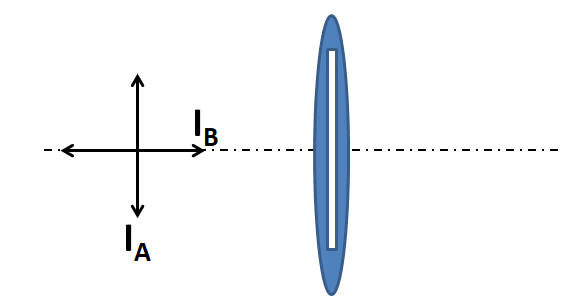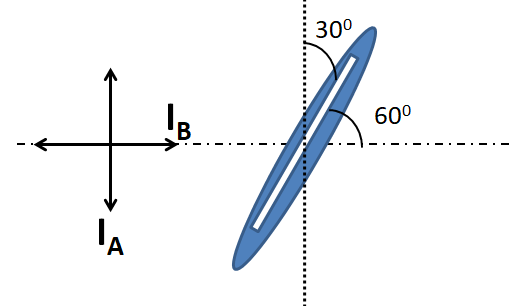
A Polaroid examines two adjacent plane polarised beams A and B, whose planes of polarization are mutually perpendicular. In the first position of the analyzer, beam B shows zero intensity. From the position a rotation of ${30^ \circ }$ shows the two beams have same intensity. The ratio of intensities of the two beams ${{\text{I}}_{\text{A}}}$ and ${{\text{I}}_{\text{B}}}$ will be:
(A) $1:3$
(B) $3:1$
(C) $\sqrt 3 :1$
(D) $1:\sqrt 3 $
Answer
218.4k+ views
Hint: To solve this question, we need to find out the initial position of the Polaroid with respect to the beams A and B. Then after the given rotation, we have to find its final position with respect to the both beams. Finally using the Malus law we can get the final answer.
Complete step-by-step solution:
We know that a Polaroid allows the components of the vibration of a light which are parallel to its axis. All the vibration components perpendicular to the axis of the Polaroid are restricted by the Polaroid. The intensity of the transmitted light as seen from the Polaroid is given by the Malus law as
$I = {I_0}{\cos ^2}{{\theta }}$..................(1)
From the above relation, we can see that the intensity of the transmitted light from the Polaroid is maximum when ${{\theta }} = {0^ \circ }$, and it is minimum for ${{\theta }} = {90^ \circ }$.
According to the question the initial position of the Polaroid is such that the beam B has zero intensity. So vibrations of the beam B must be perpendicular to the Polaroid axis. Since the planes of polarization of the beams A and B are mutually perpendicular, the vibrations of beam A must be parallel to the Polaroid axis as shown in the below diagram.

Now, according to the question, the Polaroid is rotated through an angle of ${30^ \circ }$, as shown below.

As we can see that now the Polaroid axis is inclined at an angle of ${30^ \circ }$ with the direction of the beam A, and at an angle of ${60^ \circ }$ with the direction of the beam B.
For beam A:
According to the question, the initial intensity of beam A is ${{\text{I}}_{\text{A}}}$. Also, the angle between the Polaroid axis and the beam A is equal to ${30^ \circ }$. Therefore substituting \[{I_0} = {{\text{I}}_{\text{A}}}\] and \[{\text{\theta }} = {30^ \circ }\] in (1) we get
\[{I_{\text{A}}}' = {I_{\text{A}}}{\cos ^2}{30^ \circ }\]..............(2)
For beam B:
According to the question, the initial intensity of beam B is ${{\text{I}}_{\text{B}}}$. Also, the angle between the Polaroid axis and the beam A is equal to ${60^ \circ }$. Therefore substituting \[{I_0} = {{\text{I}}_{\text{B}}}\] and \[{\text{\theta }} = {60^ \circ }\] in (1) we get
\[{I_{\text{B}}}' = {I_{\text{B}}}{\cos ^2}{60^ \circ }\].................(4)
According to the question, the two beams are appearing equally bright as seen from the Polaroid. This means that the intensities of the transmitted light of the beams A and B are equal, that is,
\[{I_{\text{A}}}' = {I_{\text{B}}}'\]
From (3) and (4)
\[{I_{\text{A}}}{\cos ^2}{30^ \circ } = {I_{\text{B}}}{\cos ^2}{60^ \circ }\]
\[ \Rightarrow \dfrac{{{I_{\text{A}}}}}{{{I_{\text{B}}}}} = \dfrac{{{{\cos }^2}{{60}^ \circ }}}{{{{\cos }^2}{{30}^ \circ }}}\]
We know that $\cos {30^ \circ } = \dfrac{{\sqrt 3 }}{2}$ and $\cos {60^ \circ } = \dfrac{1}{2}$. Therefore we get
\[\dfrac{{{I_{\text{A}}}}}{{{I_{\text{B}}}}} = \dfrac{{{{\left( {1/2} \right)}^2}}}{{{{\left( {\sqrt 3 /2} \right)}^2}}}\]
\[ \Rightarrow \dfrac{{{I_{\text{A}}}}}{{{I_{\text{B}}}}} = \dfrac{1}{3}\]
Thus, the required ratio is equal to $1:3$.
Hence, the correct answer is option 1.
Note: Always try to draw the diagram corresponding to this type of problem. This is done in order to be sure about the angle of inclination of the Polaroid axis with respect to the light beam.
Complete step-by-step solution:
We know that a Polaroid allows the components of the vibration of a light which are parallel to its axis. All the vibration components perpendicular to the axis of the Polaroid are restricted by the Polaroid. The intensity of the transmitted light as seen from the Polaroid is given by the Malus law as
$I = {I_0}{\cos ^2}{{\theta }}$..................(1)
From the above relation, we can see that the intensity of the transmitted light from the Polaroid is maximum when ${{\theta }} = {0^ \circ }$, and it is minimum for ${{\theta }} = {90^ \circ }$.
According to the question the initial position of the Polaroid is such that the beam B has zero intensity. So vibrations of the beam B must be perpendicular to the Polaroid axis. Since the planes of polarization of the beams A and B are mutually perpendicular, the vibrations of beam A must be parallel to the Polaroid axis as shown in the below diagram.

Now, according to the question, the Polaroid is rotated through an angle of ${30^ \circ }$, as shown below.

As we can see that now the Polaroid axis is inclined at an angle of ${30^ \circ }$ with the direction of the beam A, and at an angle of ${60^ \circ }$ with the direction of the beam B.
For beam A:
According to the question, the initial intensity of beam A is ${{\text{I}}_{\text{A}}}$. Also, the angle between the Polaroid axis and the beam A is equal to ${30^ \circ }$. Therefore substituting \[{I_0} = {{\text{I}}_{\text{A}}}\] and \[{\text{\theta }} = {30^ \circ }\] in (1) we get
\[{I_{\text{A}}}' = {I_{\text{A}}}{\cos ^2}{30^ \circ }\]..............(2)
For beam B:
According to the question, the initial intensity of beam B is ${{\text{I}}_{\text{B}}}$. Also, the angle between the Polaroid axis and the beam A is equal to ${60^ \circ }$. Therefore substituting \[{I_0} = {{\text{I}}_{\text{B}}}\] and \[{\text{\theta }} = {60^ \circ }\] in (1) we get
\[{I_{\text{B}}}' = {I_{\text{B}}}{\cos ^2}{60^ \circ }\].................(4)
According to the question, the two beams are appearing equally bright as seen from the Polaroid. This means that the intensities of the transmitted light of the beams A and B are equal, that is,
\[{I_{\text{A}}}' = {I_{\text{B}}}'\]
From (3) and (4)
\[{I_{\text{A}}}{\cos ^2}{30^ \circ } = {I_{\text{B}}}{\cos ^2}{60^ \circ }\]
\[ \Rightarrow \dfrac{{{I_{\text{A}}}}}{{{I_{\text{B}}}}} = \dfrac{{{{\cos }^2}{{60}^ \circ }}}{{{{\cos }^2}{{30}^ \circ }}}\]
We know that $\cos {30^ \circ } = \dfrac{{\sqrt 3 }}{2}$ and $\cos {60^ \circ } = \dfrac{1}{2}$. Therefore we get
\[\dfrac{{{I_{\text{A}}}}}{{{I_{\text{B}}}}} = \dfrac{{{{\left( {1/2} \right)}^2}}}{{{{\left( {\sqrt 3 /2} \right)}^2}}}\]
\[ \Rightarrow \dfrac{{{I_{\text{A}}}}}{{{I_{\text{B}}}}} = \dfrac{1}{3}\]
Thus, the required ratio is equal to $1:3$.
Hence, the correct answer is option 1.
Note: Always try to draw the diagram corresponding to this type of problem. This is done in order to be sure about the angle of inclination of the Polaroid axis with respect to the light beam.
Recently Updated Pages
Chemical Properties of Hydrogen - Important Concepts for JEE Exam Preparation

JEE General Topics in Chemistry Important Concepts and Tips

JEE Atomic Structure and Chemical Bonding important Concepts and Tips

JEE Amino Acids and Peptides Important Concepts and Tips for Exam Preparation

JEE Extractive Metallurgy Important Concepts and Tips for Exam Preparation

Algebra Made Easy: Step-by-Step Guide for Students

Trending doubts
JEE Main 2026: Application Form Open, Exam Dates, Syllabus, Eligibility & Question Papers

Derivation of Equation of Trajectory Explained for Students

Hybridisation in Chemistry – Concept, Types & Applications

Understanding the Angle of Deviation in a Prism

Understanding Collisions: Types and Examples for Students

Understanding Atomic Structure for Beginners

Other Pages
JEE Advanced Marks vs Ranks 2025: Understanding Category-wise Qualifying Marks and Previous Year Cut-offs

Units And Measurements Class 11 Physics Chapter 1 CBSE Notes - 2025-26

NCERT Solutions For Class 11 Physics Chapter 8 Mechanical Properties Of Solids

Motion in a Straight Line Class 11 Physics Chapter 2 CBSE Notes - 2025-26

NCERT Solutions for Class 11 Physics Chapter 7 Gravitation 2025-26

How to Convert a Galvanometer into an Ammeter or Voltmeter




